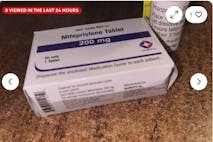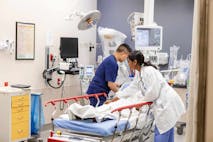
Details shrouded in secrecy as third woman in a month is injured at Rhode Island Planned Parenthood
Bridget Sielicki
·
Abortion Pill·By Bettina di Fiore
JAMA’s abortion pill study is an extreme outlier… and an admitted effort to promote abortion
On June 24 – the two-year anniversary of the overturning of Roe v. Wade – the Journal of the American Medical Association (JAMA) published a study which purported to compare the safety and efficacy of chemical abortions obtained either in-person (following an ultrasound) or through the mail (using the so-called “no-test” protocol, in which no in-person doctor visit occurs, and no lab work or ultrasounds are performed). It concluded that “medication abortion following no-test telehealth screening and mailing of medications” has “a low prevalence of adverse events.”
But how reliable is this study? What does the data in it really show? And how does this study compare to other, similar research?
Study details
The no-test group initially consisted of 228 women, while the in-person group included 238 women. Of these, a number of participants did not provide follow-up data, leaving a final participant number of 204 for the no-test group and 220 for the in-person group. The follow-up period covered by the study was four weeks.
These are fairly small sample sizes, and four weeks is a relatively short follow-up period.
Dr. Michael New, who is an assistant professor of practice at the Busch School of Business at the Catholic University of America and a senior associate scholar at the Charlotte Lozier Institute, told Live Action News that these are significant weaknesses of the study.
“There are reasons to be skeptical of the findings of the recent JAMA study that compares risks of telehealth abortion to in-person abortion,” Dr. New said. “First, the researchers received no data from 8 percent of the people who enrolled in the study. Secondly, they only tracked outcomes for four weeks. It is possible that [additional] adverse effects of telehealth abortion might have emerged, had the study tracked participants over a longer timespan.”
Dr. New concluded: “It is my opinion that a study that utilized a larger sample size and tracked recipients for a longer period of time would have more clearly demonstrated the risks involved with obtaining chemical abortions without in-person medical supervision.”
“Low prevalence of adverse events”
The study claims to have observed few adverse events, but its definition of what constitutes an “adverse event” is fairly narrow. “Serious adverse events” as defined by this study include “overnight hospitalization, blood transfusion, and emergency surgery” – but not emergency room or urgent care visits which did not result in overnight inpatient admission, although these have been included in similar studies and other investigations into the outcomes of the no-test protocol.
The study reports only seven (7) total “serious adverse events,” experienced by six different individuals – three in the no-test group and three in the in-person group.
One participant required emergency surgery for an ectopic pregnancy. The study does not appear to report whether this woman had been placed in the no-test group or the in-person group. But, given that the in-person group underwent ultrasounds prior to being given the abortion pill, it is far more likely that she was in the no-test group. Barring incompetence on the part of the ultrasound technician, her condition would have been discovered, and her eligibility to participate in this study would have been revoked, if she had been in the in-person group.
Taking the abortion pill when one has an ectopic pregnancy is extremely dangerous and can even prove fatal for the mother. Since the no-test protocol was put into wide practice, cases of women requiring emergency care after taking the abortion pill while experiencing ectopic pregnancies have been reported, and even the abortion industry has admitted that this can, and will, occur.
Article continues below
Dear Reader,
In 2026, Live Action is heading straight where the battle is fiercest: college campuses.
We have a bold initiative to establish 100 Live Action campus chapters within the next year, and your partnership will make it a success!
Your support today will help train and equip young leaders, bring Live Action’s educational content into academic environments, host on-campus events and debates, and empower students to challenge the pro-abortion status quo with truth and compassion.
Invest in pro-life grassroots outreach and cultural formation with your DOUBLED year-end gift!
Because the number of women experiencing adverse events (as narrowly defined by this particular study) was the same for both groups, study authors conclude that the no-test abortion pill protocol is equally as safe as requiring abortion pill customers to see a doctor. However, the woman with an undiagnosed ectopic pregnancy was placed in a situation which significantly increased the odds of her death, calling into question whether both methods are equally “safe.”
Comparison to similar studies
Other investigations into the “safety” of the no-test protocol in both the United States and United Kingdom have reported much higher complication rates – around 6% in both cases. However, as noted previously, these inquiries included emergency room and urgent care visits in their definitions of “adverse events.” They also had significantly larger sample sizes (1,157 and over 200,000, respectively).
The label information for Mifeprex (the abortion pill) indicates that between 2.9 and 4.6 percent of women who take the drug will end up in the emergency room, and the drug’s medication guide admits that up to 7% of women who take the abortion pill will require subsequent surgery to stop bleeding or to complete their abortions.
And yet, this JAMA study reports a “serious adverse event” rate of only 1.1%.
Obvious bias and an admitted agenda
At best, this study is an extreme outlier among existing research on this topic. At worst, it is a gross misrepresentation of reality.
But why would medical scientists – who are presumed to be objective by most average people – wish to distort the facts about abortion industry practices and the safety of the abortion pill itself?
One need look no further than the language of this study for answers.
Study authors not only describe telehealth and no-test abortion as “safe and effective,” but also describe the “expansion” of this practice as “urgently needed” in order “to overcome at least some of the logistical and geographic barriers to accessing abortion.”
In other words, not only are study authors not neutral on the issue of abortion, but they actually wish to promote abortion and increase the number of children who are killed by it. What’s more, they openly state their wish to use their data in the political arena to advocate for abortion, writing: “Study findings may also be used to refute ongoing efforts to further regulate and restrict access to medication abortion[.]”
In sum, this study amounts to little more than abortion activism cloaked beneath a veneer of science. The fact that such an agenda is being advanced by the once-respectable Journal of the American Medical Association is by no means surprising — after all, this particular study is just one of several recent efforts by the publication to promote prenatal homicide and weaponize medicine for propagandic purposes.
Live Action News is pro-life news and commentary from a pro-life perspective.
Contact editor@liveaction.org for questions, corrections, or if you are seeking permission to reprint any Live Action News content.
Guest Articles: To submit a guest article to Live Action News, email editor@liveaction.org with an attached Word document of 800-1000 words. Please also attach any photos relevant to your submission if applicable. If your submission is accepted for publication, you will be notified within three weeks. Guest articles are not compensated (see our Open License Agreement). Thank you for your interest in Live Action News!

Bridget Sielicki
·
Human Interest
Andrea Trudden
·
Abortion Pill
Carole Novielli
·
Abortion Pill
Carole Novielli
·
Abortion Pill
Carole Novielli
·
Abortion Pill
Bridget Sielicki
·
International
Bettina di Fiore
·
Human Rights
Bettina di Fiore
·
Politics
Bettina di Fiore
·
Human Interest
Bettina di Fiore
·
Activism
Bettina di Fiore
·